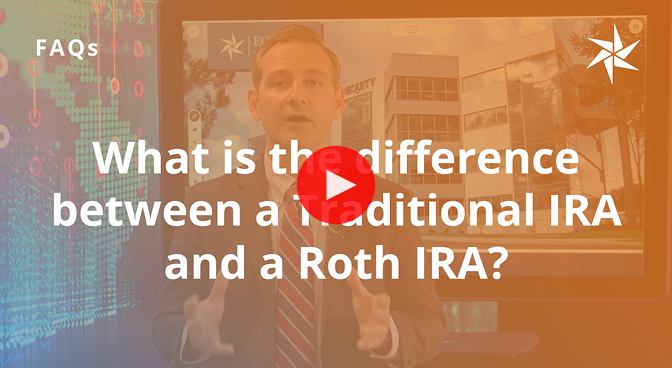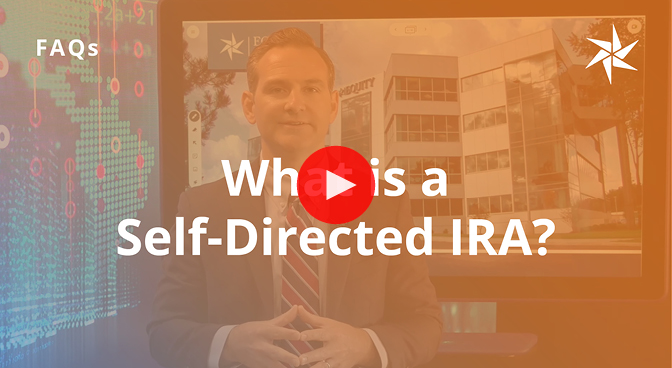What is a Traditional IRA?
A Traditional IRA (Individual Retirement Account) is a type of retirement savings account that allows those who qualify to contribute pre-tax income toward investments that can grow tax-deferred until withdrawal. This means that contributions to a Traditional IRA may lower your taxable income for the year the contributions are made, potentially reducing your overall tax liability. Taxes are then paid on the money when it is withdrawn from the account during retirement.
Traditional IRAs are a popular choice for retirement savings due to their tax advantages, providing a straightforward way for individuals to save and invest for their retirement years. At Equity Trust Company, you can self-direct your Traditional IRA to invest in a broad range of asset types, including real estate, private equity, cryptocurrency, precious metals, and much more.
Videos


Benefits of a Traditional IRA
Secure retirement: IRAs are designed to be long-term retirement savings vehicles, with the potential to significantly impact your financial security in retirement. The earlier you start contributing, the more potential your savings have to grow due to compounding interest.
Tax savings: Traditional IRAs enable you to grow your retirement account over time tax-deferred, while also possibly qualifying for yearly tax deductions. Plus, any profits you make from investments in an IRA are not subject to capital gains taxes. While the money is taxed when withdrawn, often owners are in a lower tax bracket at that point in their life.
Fewer income restrictions: Unlike a Roth IRA, there is no income limitation to contribute to a Traditional IRA. The only requirement to contribute is that you have earned income.
Investment flexibility: There are nearly endless investment options for Traditional IRAs. This means you can expand your portfolio into alternative investments, into assets you know and understand while diversifying your risk.
Interested in alternative investments but don’t know where to start?
No problem. We make it easy to locate potential investments.
Available through our online account management system, myEQUITY, the WealthBridge portal provides a secure, direct connection to alternative asset investment platforms.
Discover WealthbridgeOur online marketplace introduces you to dozens of asset providers across various investment types including turnkey real estate, private equity, cryptocurrency, precious metals, and more.
Visit Investment DistrictContribution Limits for a Traditional IRA
The IRS sets limits for how much you can contribute to a Traditional IRA each year. See the current year’s contribution limits.
If you’re 50 or older, you can take advantage of “catch-up contributions,” which mean you can contribute an extra $1,000.
Traditional IRA Contribution Limits and Deadline
| 2025 | 2024 | |
| Standard Contribution Limit | $7,000 | $7,000 |
| Catch-Up Contribution Limit (Age 50 and Older) | $8,000 | $8,000 |
| Contribution Deadline | 4/15/2026 | 4/15/2025 |
| 2024 | |
| Standard Contribution Limit | $7,000 |
| Catch-Up Contribution Limit (Age 50 and Older) | $8,000 |
| Contribution Deadline | 4/15/2025 |
Traditional IRA Eligibility Requirements
Anyone who has compensation is eligible to make a contribution to a Traditional IRA.
Which compensation qualifies? Compensation is defined as the wages, salaries, commissions, bonus, alimony and any other amount that you receive for providing personal services. For individuals who are self-employed, sole proprietors and partners in a partnership, “earned income” is another term for compensation.
Which compensation doesn’t qualify? Passive income such as interest, dividends and most rental income are not considered compensation for the purpose of funding an IRA.
Traditional IRA Rules
Contribution limits: As mentioned above, the IRS sets annual limits to how much you can contribute to a Traditional IRA. These limits can change from year to year based on inflation adjustments.
Related: What happens if you over-contribute to your IRA?
Limitations for tax deductions on contributions: Traditional IRA contributions may qualify for tax deductions if you meet eligibility requirements. Qualification depends on a variety of factors, including whether you’re covered by a retirement plan at work and your income.
Required minimum distributions: Starting at age 73, you must take required minimum distributions (RMDs) from your IRA each year, to ensure that the savings are eventually drawn down.
Early withdrawal penalties: Withdrawals can be made from a Traditional IRA without penalties starting at age 59½. Withdrawing funds from the account before age 59½ generally results in a 10-percent penalty on the amount withdrawn, in addition to the normal income tax due, although there are exceptions for specific circumstances like buying a first home or paying for qualified education expenses. Learn more about withdrawal rules.
Traditional IRA and Taxes
Contributions to a Traditional IRA are made with pre-tax income, and taxes are deferred until the funds are withdrawn. Likewise, any investment earnings (such as interest, dividends, or capital gains) are not taxed until they are withdrawn, usually during retirement, when the account holder may be in a lower tax bracket.
Here’s a summary of the difference between Traditional IRAs and Roth IRAs, including tax treatment:
| Traditional IRA | Roth IRA | |
| Tax Advantages | Account balances compound tax-deferred until funds are withdrawn | Account balances compound tax-deferred. BUT funds that are withdrawn are tax-free if account is five years old and account owner is over 59 1/2 |
| Eligibility | Individuals must have earned income* | Individuals must have earned income* and modified adjusted gross income less than current limits (see www.irs.gov for details) |
| Tax Deductions on Contributions | Yes | No |
| Penalties for Early Withdrawal | 10% penalty for withdrawals before age 59 1/2 | 10% penalty for withdrawals before age 59 1/2 and five year seasoning period (Note: Roth contributions can be taken out at any time without penalty) |
| Exceptions for 10% Penalty | Yes | Yes |
| Cut-off Age for Contributions | No limit | No limit |
| Required Distributions | Yes. You must take your first required minimum distribution by April 1 of the year after you turn 72 (70 1/2 if you reached 70 1/2 by January 1, 2020) | None |
| Traditional IRA | |
| Tax Advantages | Account balances compound tax-deferred until funds are withdrawn |
| Eligibility | Individuals must have earned income* |
| Tax Deductions on Contributions | Yes |
| Penalties for Early Withdrawal | 10% penalty for withdrawals before age 59 1/2 |
| Exceptions for 10% Penalty | Yes |
| Cut-off Age for Contributions | No limit |
| Required Distributions | Yes. You must take your first required minimum distribution by April 1 of the year after you turn 72 (70 1/2 if you reached 70 1/2 by January 1, 2020) |
* Earned income is defined as the salary or wages you receive as an employee. If you’re self-employed, earned income is your net income for personal services performed. Passive income such as interest, dividends, and most rental income are not considered compensation for the purpose of funding an IRA. Consult a financial professional to determine your earned income.
Getting Started with a Traditional IRA
Here are the three steps to getting started with an Equity Trust self-directed IRA:
Open your Equity Trust Traditional IRA
One of our specialized IRA Counselors will walk you through the process, or you can do it online through our account management system myEQUITY.
Fund your new tax-advantaged account
You can fund your account via rollover, transfer, or out-of-pocket contribution.
Select your investment and direct Equity Trust to fund it
myEQUITY investment wizards walk you through submitting your investment online. Our liaisons are ready to assist if you need it.
Traditional IRA FAQs
How do you contribute to a Traditional IRA?
Equity Trust makes it easy for you to contribute to a Traditional IRA through our online account management system myEQUITY. You can electronically transfer money from a bank account or send a vcheck.
The IRS sets limits for how much you can contribute to a Traditional IRA each year. See the current year’s contribution limits.
Is a Traditional IRA the same as a 401(k)?
While they have some similarities, the Traditional IRA and 401(k) are two different accounts. The primary difference is that a 401(k) is offered through an employer, where a Traditional IRA is an account an individual opens to save for retirement.
Another difference between the accounts is the contribution limits: the 401(k) enables you to save more each year.
What is the difference between Roth IRA and Traditional IRA?
The main difference between a Traditional IRA and a Roth IRA is the timing of taxation. Contributions to a Traditional IRA are made pre-tax and may provide a tax deduction for the year of contribution (pending eligibility requirements). Investments and earnings within the IRA are tax-deferred, but funds distributed after age 59½ are taxed at the account owner’s ordinary income tax rate.
Conversely, contributions to a Roth IRA are made after-tax and do not provide a tax deduction. However, investments and earnings within a Roth IRA are tax-free, and funds distributed after age 59½ are tax-free and not taxed as ordinary income as long as the account has been established for at least five years.
One other difference between the two account types is eligibility. With a Traditional IRA, you need to have earned income to contribute to an account. With a Roth IRA, you also need to have earned income, but your income can’t exceed a certain amount for you to be eligible to contribute. Learn more about the account differences.
Can you have a Traditional IRA and a Roth IRA?
Yes, it is possible to open and contribute to both a Traditional IRA and a Roth IRA, but it’s important to understand the accounts’ different tax environments and the rules regarding contributions to make sure it’s the right move for you. Read more about having a Traditional and Roth IRA.
Is a rollover IRA a Traditional IRA?
“Rollover IRA” refers to an account that you’ve rolled over from a plan with a former employer, such as a 401(k) or 4013(b). There are several types of accounts that can hold the rolled-over funds – including a Traditional IRA. One of the key requirements for a rollover is that the funds are being transferred to a like tax environment (pre-tax contributions to pre-tax contributions, for example). Read more about rollovers.
Is a SIMPLE IRA the same as a Traditional IRA?
The SIMPLE IRA is designed for businesses with 100 or fewer employees. A Traditional IRA is for individual investors who earn qualified income and is not offered through an employer.
Other differences between the two accounts are the annual contribution limits as well as the tax environments. Compare account contribution limits and other details.
How do you convert a Traditional IRA to Roth IRA?
You would need to perform a Roth IRA conversion. Note that you’re transferring your account from one tax environment to another, which will trigger taxes in the year in which you perform the conversion. For more details, watch this video about Roth IRA conversions.
Can high income earners contribute to a Traditional IRA?
Unlike Roth IRAs, a Traditional IRA doesn’t have income limits for those who can contribute to the account. Anyone with earned income can contribute to a Traditional IRA including high income earners. There are income limits, however, on the total tax-deductible contributions made to the account.
Self-Directed Traditional IRA FAQs
What is a self-directed Traditional IRA?
A self-directed Traditional IRA is technically no different than any other IRA or 401(k). A self-directed IRA is unique because of the investment options available. Most IRAs are used for stocks, bonds, mutual funds and CDs. A self-directed IRA allows those types of investments along with real estate, notes, private placements, and other alternative investment options.
Can you convert a Traditional IRA to a self-directed IRA?
It is possible to transfer funds to an Equity Trust IRA from an IRA you hold at another custodian or a retirement plan from a prior employer, provided the tax environments are the same. A Traditional IRA held by another custodian needs to have its funds transferred to an Equity Trust Traditional self-directed IRA. A Roth IRA needs to have its funds moved to a Roth IRA.
Our IRA Counselors can help you determine what type of account you need to open at Equity Trust to move your funds in an approved manner.
Who offers self-directed IRAs?
To open a self-directed IRA, you need a custodian, a financial institution that securely holds your account’s investments and ensures compliance with all IRS and government regulations. Custodians provide the necessary services to manage and administer the diverse range of investments that self-directed IRAs can hold, such as real estate, precious metals, private equity, and cryptocurrencies.






